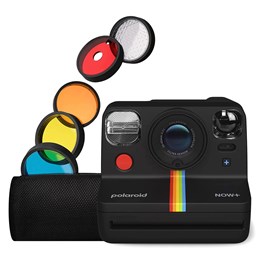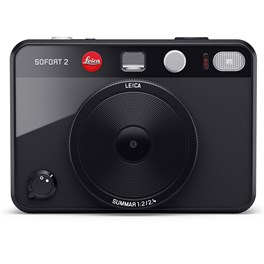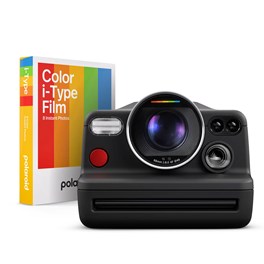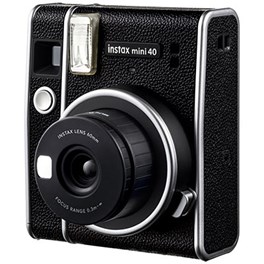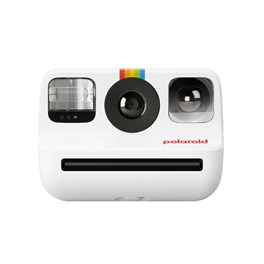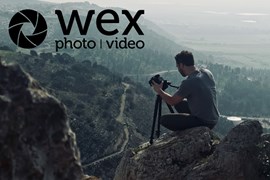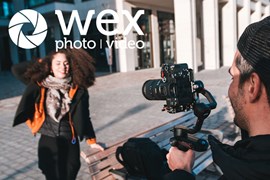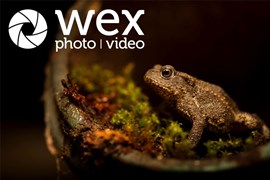
The best instant cameras in 2024 are the ideal way to give your picture-taking some knockabout magic. Recapturing the magic of Polaroids at parties in decades gone by, a great instant camera lets you forget about pixel-peeping and focus on fun. Also, having a physical print of an image is a wonderful way to take yourself out of the digital space for a while. Want to make a photobook or wall-hanging of photographic memories? An instant camera is the perfect way to do it.
When we talk about instant cameras, we’re referring to two specific categories, both of which are represented in this guide. These are as follows:
Instant film cameras – The classic format, and probably what you’re picturing when you read the phrase instant camera. You hit the shutter button, there’s a flash, and then the camera spits out a sheet of film. It develops for a few minutes, and then voila, you have your instant film photo. Polaroid cameras, new and old, are instant film cameras, as are Fujifilm’s Instax models.
Instant print cameras – Also known as digital instant print cameras, these models are essentially a digital camera combined with an instant printer. Hit the shutter and the photo you capture is instantly transferred to fast-printing photo paper, producing a physical copy of your image moments later. While the quality isn’t up to the standards of instant film, and you don’t quite get that lo-fi look, instant print cameras are much more cost-effective to run. Canon has an interesting line in instant-print cameras, which use its proprietary ZINK (zero-ink) photo paper.
Modern instant cameras also benefit from a few features that old Polaroid cameras from the 1970s notably did not have, like wireless connectivity that allows you to trigger them using your smartphone, or save digital copies of your images. You also can make use of specialist shooting modes like double-exposure or self-timer, or load up with different film types for creative effects.
We’ve pulled together all the best instant cameras you can buy from Polaroid, Fujifilm, Leica and Canon, with options available for all budgets.
Quick Navigation
Best Instant Film Camera
We can all admit it – instant film is just cool. Snapping shots and a few minutes later having a glorious analogue Polaroid or Instax print in your hand is infectious fun, and all the megapixels in the world can’t capture the same magic. In this first section of the guide, we’ve picked out quite simply our favourite instant film cameras you can buy right now.
For this section, we’ve assembled a stunning series of cameras for snapping instant film images, with options from Polaroid and Fujifilm. Whether you crave full manual control, smartphone integration, wide-format prints or some combination of the above, these are the cameras that will meet your standards.
Whichever brand you choose, you’ve got a highly capable instant film camera that can create fantastic physical prints in moments, while still being simple enough that practically anyone can use it.
Polaroid Now Plus Gen II Instant Camera - Black
The iconic Polaroid analogue camera is now even more user-friendly, Bluetooth compatible, and selfie-ready with the Polaroid Now Plus Gen II. With an improved flash, a self-timer, and a double-exposure option, the Gen II is designed with you in mind. Also controllable via the Polaroid app, the Plus version camera includes 5 coloured lenses to take your creative photography to the next level.
£139.00 View
Pros:
- Consistently produces well-exposed, great-looking prints
- USB-C connection for fast charging
- Creative modes like Double Exposure
Cons:
- Not worth the upgrade if you already have Gen 1
If you want a fairly straightforward instant film camera that consistently delivers fantastic prints, the Polaroid Now Plus Gen II is an easy recommendation. A minor refresh of the popular Polaroid Now Plus, this camera doesn’t make too many radical changes. The Micro USB port is upgraded to USB-C, the close-up lens is a bit better and there are some overall operability improvements that mean exposures are more consistently accurate especially in Tripod Mode.
If you already have the previous-generation Now Plus, these features probably aren’t worth upgrading for by themselves, but if you’re shopping for one of your first instant film cameras, the Polaroid Now Plus Gen II is one of the best buys you can make. It’s easy to use, but also allows a measure of manual control, with options to tweak the aperture and shutter speed if necessary. Compatible with Polaroid i-Type film and 600 film, the Now Plus can also connect to your smartphone via Bluetooth for remote triggering.
Fujifilm Instax Wide 300 Film Camera - Toffee
Capture stunning close-ups with the Fujifilm Instax Wide 300 Film Camera, boasting a 95mm lens, adjustable focus zones, and a retro design. This trendy camera offers automatic exposure control, ensuring perfect shots every time, and uses the expansive "instax WIDE" film for high-quality prints.
£99.00 View
Pros:
- Big, wide prints look great
- Easy to use
- 95mm lens with multiple focus zones
Cons:
- Relatively big and bulky
- No built-in rechargeable battery (powered by AAs)
While tiny Instax mini prints can be a lot of fun, many instant film enthusiasts find themselves craving something a little larger. To scratch that itch, Fujifilm has helpfully come out with Instax Wide film – with an image area measuring 99 mm x 62 mm, these prints provide considerably more real estate than Instax Mini, and a wider edge even than Polaroid I-Type.
Of course, bigger film requires a bigger camera, and the Fujifilm Instax Wide 300 Film Camera is accordingly a fairly hefty prospect to tote around. You won’t be elegantly slipping this into a bag the way you would an Instax Mini 40 or a Polaroid Go. Still, with a rounded shape and grip, the camera is comfortable to hold and use, and there is a limited degree of user control to fine-tune your shots. You can select one of two focus zones for the 95mm equivalent lens, and the exposure can be adjusted in three steps for a brighter or darker image.
Leica SOFORT 2 Instant Camera - Black
Discover the Leica SOFORT 2, a mini instant camera crafted in Germany, boasting seamless connectivity to the Leica FOTOS App and a suite of creative effects. Effortlessly print your chosen memories, control remotely, and indulge in the elegant design synonymous with Leica.
£350.00 View
Pros:
- Stylish, functional design
- Can use affordable Instax Mini film
- Leica FOTOs app expands functionality
Cons:
- Digital files aren’t the best quality
- More expensive than Fujifilm Instax versions
With that unmistakable red dot, this instant camera simply oozes Lecia quality. It’s beautifully made, with a timeless appearance and a variety of colour options, and the Sofort 2 also captures images in both digital and analogue formats. It prints out on Instax Mini film, while saving a digital copy of an image to a micro SD card. You may or may not get much use out of the latter feature – with 4.9MP of resolution, there are certainly better cameras out there to capture digital files on – but it’s handy to have.
There are also loads of creative filters you can apply to your images to create specific effects – we particularly like the monochrome options. The Leica Sofort 2 can also connect to the Leica Fotos app via Bluetooth, further expanding your shooting options and flexibility, including the option to control the camera remotely.
Polaroid I-2 Instant Camera - Black
The iconic Polaroid analogue camera is even more advanced and user-friendly with the 98mm f/8 lens Polaroid I-2 Instant Camera. It boasts 6 shooting modes, an integrated settings display, and selectable shutter speeds from 1/250 to 30 secs. With apertures from f/8 to f/64, it's perfect for creative shots on Color i-Type film. The internal battery is charged via USB-C and ready to go when you are.
£599.00 View
Pros:
- Full manual and auto exposure control
- Sharp, fast 98mm lens
- 49mm filter thread mount
Cons:
- More expensive than other Polaroids
We often talk about instant photography as knockabout fun – well, this is a camera for those who want to take it a little more seriously. The Polaroid I-2 Instant Camera is definitely the best instant camera you can buy right now in terms of being the most sophisticated – with the option to take full manual control of exposure settings, as well as LiDAR autofocus, it’s streets ahead of most other instant cameras, which tend to offer not a whole lot more than point-and-shoot.
Does everybody need this kind of functionality? No, probably not – which is why the I-2 doesn’t sit at the top of our list. It’s going to appeal to a relatively small subset of instant film enthusiasts, those who are interested in instant imagery more as art than entertainment. If that sounds like you, then the Polaroid I-2 will more than justify its considerably higher price tag than other Polaroid cameras.
Best Instant With Cheap Film
While instant cameras themselves are inexpensive to buy, something you have to account for is the ongoing cost of film. Unlike digital cameras, which can effectively shoot indefinitely, or at least until the shutter unit wears out, an instant camera has to be reloaded every time you run through a pack of film. And if you’re someone who likes to be liberal with their shots, that can happen quite frequently.
The solution is to pick up an instant camera that uses a cheaper film. We reckon your best bet is a camera that uses Fujifilm’s smallest format – Instax Mini. It’s still film, meaning you still get the analogue look that you don’t get with digital prints, but with a smaller image area compared to Polaroid or Instax Square, measuring 46 mm x 62 mm. Instax Mini cameras tend to be extremely straightforward to use, too, meaning they’re great for kids as well as adults.
Fujifilm Instax Mini 12 Instant Film Camera - Clay White

Get unique and long-lasting keepsakes in seconds with the Fujifilm INSTAX Mini 12 Instant Film Camera. With a distinctive bubbly design, automatic exposure and flash control, and a handy selfie mirror, this camera lets you capture life's special moments however and wherever you want. Whether taking a group photo or snapping a selfie, the INSTAX Mini 12 is a great everyday companion.
£79.00 View
Fujifilm Instax Mini 12 Instant Film Camera - Mint Green

Get unique and long-lasting keepsakes in seconds with the Fujifilm INSTAX Mini 12 Instant Film Camera. With a distinctive bubbly design, automatic exposure and flash control, and a handy selfie mirror, this camera lets you capture life's special moments however and wherever you want. Whether taking a group photo or snapping a selfie, the INSTAX Mini 12 is a great everyday companion.
£79.00 View
Pros:
- New twist-action lens mechanism
- Affordable camera, affordable film
- 5 striking colour options
Cons:
- Flash can’t be disabled
- Bias towards overexposure in daylight
The Fujifilm Instax Mini 12 is the newest camera off the production line in Fujifilm’s Instax range. It doesn’t reinvent the wheel from the previous Instax Mini 11 (which you’ll meet further on in this guide) but it keeps what instant photographers have long loved about these cameras – that simplicity of use and charm. There’s no settings control – you can’t change the exposure or even turn off the flash – but you just point, and shoot, and seconds later you have a fully realised physical print. It also benefits from a new twisting lens mechanism, which is used to turn on the camera and activate the close-up mode.
The Fujifilm Instax Mini film this camera takes is some of the cheapest on the market, and you can pick it up for even less by experimenting with different types like Mini Black Frame or Mini Macaron Deco, which has a patterned border. There are also discounts on the film if you buy it bundled with the camera, so if this is the instant camera for you, stock up on purchase to make some savings. The Instax Mini 12 is available in multiple colour options, so pick your favourite!
Best Instant Print Camera
With an instant print camera, you can produce physical prints of your images at a much lower cost than you would with instant film. Currently, the market leader in this regard is Canon, who produces its own line of ZINK (zero-ink) photo paper onto which images can be quickly transferred to create a smudge-proof print in minutes. The way it works is that the ink is actually contained in the paper itself, and is mixed around using pressure to create the digital image.
This means there’s no need to fill up on ink cartridges and the like – the paper itself is all you need. While the quality isn’t the same as instant film or as conventional printing, the images are produced quite quickly, and once they’re ready, they’re very durable, resistant to smudges and splashes. Plus, digital print cameras will also save digital copies of the images you take either to a microSD card or their own internal storage, so you get both the physicality of analogue prints and the convenience of digital files.
Canon Zoemini S2 Instant Camera and Printer - Teal

The Canon Zoemini S2 Instant Camera and Printer has been redesigned with content creators in mind. The innovative 2-in-1 camera printing device that allows users to filter selfies, choose between shooting modes and save their favourite photos to print later. With added Bluetooth connectivity, creatives can shoot, style and share stories on socials to capture the best of all those mini moments.
£159.00 View
Canon Zoemini S2 Instant Camera and Printer - Pearl White

The Canon Zoemini S2 Instant Camera and Printer has been redesigned with content creators in mind. The innovative 2-in-1 camera printing device that allows users to filter selfies, choose between shooting modes and save their favourite photos to print later. With added Bluetooth connectivity, creatives can shoot, style and share stories on socials to capture the best of all those mini moments.
£159.00 View
Pros:
- Integrated digital storage
- App is excellent for editing options
Cons:
- No LCD display
- 8MP only
The Canon Zoemini S2 is a next-generation 2-in-1 instant camera and printer that benefits from a mirror, ring-light, remote shutter and live view, making it the perfect technology for capturing mini moments on the go. When used with Canon’s Zink Photo Paper, the Zoemini S2 is capable of printing bright and vivid snaps measuring 50 x 76.2mm in size.
The Zoemini S2’s fun and creative style is reflected in its design and is available in Rose Gold, Pearl White and Teal. The real selling point of this instant camera printer is the inclusion of a slot for an additional Micro SD card on top of 512MB of internal memory and image transfer using the Canon Mini Print app, so you can store far more photos compared to other models on the market.
Marketed as the perfect tech for selfie aficionados, it’s a shame that the Zoemini S2 lacks an LCD display for viewing snaps. But, with so many customisation and sharing options using the app, the Zoemini S2 is ideal for social media content creators wanting more than a smartphone snap.
Best Mini Instant Camera
We’ve already seen one of Fujifilm’s Instax Mini cameras – these compact instant film cameras are great for travel, parties and general day-to-day instant-film shooting. However, Fujifilm’s hugely successful Instax range contains several other cameras that shoot its popular Instax Mini film – so we thought we’d give you another option in addition to the Instax Mini 12 featured earlier in this guide.
At heart, Instax cameras work in very similar ways. They’re pretty much all point-and-shoot affairs, with little to no manual control of exposure settings, focus and the like. As we’ve seen, Instax Mini film is a fantastic, low-cost choice for getting stuck into some instant shooting. So, all that remains is to find the right mini instant camera for you!
Fujifilm Instax Mini 40 Instant Camera
Classic, stylish and retro. The Fujifilm Instax Mini 40 Instant Camera comes as part of Fujifilm's widely appreciated Instax instant camera range, producing super-high-quality credit-card-sized prints for you to share with your friends and family. The camera sports a premium textured black finish with silver accents that are reminiscent of classic Fujifilm film cameras. It's simple and easy-to-use thanks to built-in auto exposure, auto shutter speed and auto-brightness, as well as it being easy to frame your shot with the optical viewfinder with target spot. As well as this, you can make use of the built-in one-touch selfie lens and selfie mirror to capture those classy, timeless selfies that define your night out.
£99.00 View
Pros:
- Extremely simple to use
- Stylish design
Cons:
- No manual controls
- Flash always fires
We love the retro cool of the Fujifilm Instax Mini 40. Textured black with shiny silver trim never goes out of style, and the Instax Mini film prints it produces are positively bursting with lo-fi charm. Operation is simple point and shoot, and the camera is powered by common AA batteries. The optical viewfinder makes it easy to compose your images, and the selfie lens can be pulled when you need it.
Exposures are automatically calculated with the in-camera metering system, and the Mini 40 also comes with its own hand strap, for keeping it safe and secure. Should you want to flip it around for selfies, there’s a handy mirror on the front of the lens module for checking your framing. Like most Instax cameras, there is a bias towards overexposure in the camera’s metering system, but it never seriously compromises images, and too bright is always better than too dark.
Best Instant For Travel
Instant cameras are a fantastic choice for travel photography. They allow you to make images with a difference, capturing your adventures in a unique way that screams retro-cool. Whether you’re off on a city-break with friends, hiking in the countryside or spending a long, relaxing weekend on the beach, an instant camera can be the ideal way to make mementoes of your time away.
But how to choose the right instant camera for the job? We’ve come up with a few quite different options for this section of the guide, as different travellers are naturally going to have different priorities. Maybe you want a super-portable instant camera that can slip into a jacket pocket, something that’s easy to take everywhere even if you’re travelling light. Maybe you want something that offers a little more depth of control than most instant cameras, a lot of which offer little more than point and shoot. Or maybe you want something that offers great quality while also being budget-friendly. We’ve included all types in this section of the guide to make sure all types of traveller are covered.
Polaroid Go Gen 2 Instant Camera - White
Capture real life on the Go with Polaroid's most portable, wearable, take anywhere-able Polaroid Go Generation 2 instant camera. The Gen 2 evolution has been upgraded with a large aperture range, precise light sensor, and on-point-exposure settings to make your pictures even better. It’s really small (the smallest instant camera in the world) but comes with big creative potential featuring a selfie mirror, self-timer, double exposure, and can be paired with its own teeny tiny colour filters. All in the classic design, and now made with 30% recycled materials. Compatible with Polaroid Go film, Polaroid's smallest instant film format.
£89.00 View
Pros:
- Smallest instant film camera around
- Faster shutter and wider aperture than first GO camera
- Very easy to use
Cons:
- Can’t use regular Polaroid film (requires Go film)
- Fixed focus only
The Polaroid Go Gen 2 is the latest-gen upgrade of the dinkiest instant film camera you can buy – to go any smaller, you have to look into digital instant print cameras like the Canon Zoemini S2. As you might therefore expect, it doesn’t take regular Polaroid I-Type or 600 film, instead loading up on its own proprietary format, Polaroid Go colour film, which produces an image with an area of 47 mm x 46 mm (plus the obligatory white border).
The fact that it looks so tiny next to the bulkier Instax or Polaroid Now cameras makes the Go a tremendous travel companion, easy to slip into a jacket pocket or even clip to a belt loop. It lacks some of the fancier features of the more advanced models – unlike the Now cameras, which offer some autofocus functionality, the Go is limited to fixed focus only. However, it’s tremendously easy to use, and the prints it creates have that Polaroid ‘cool factor’ in spades.
The Go Gen 2 isn’t a huge upgrade compared to the original Go – it’s the same size and uses the same film. The improvements are subtle but immensely welcome – with faster shutter speeds, a faster aperture and improved exposure accuracy, it should result in many more ‘keepers’ and fewer wasted frames. It’s unquestionably an improvement on the original, and is a brilliant choice for travel instant photography.

Instant Camera Tips
Once you’ve got your instant camera, the fun can begin! But it can all be a bit daunting if you’ve not had much experience shooting with instant film. Here are a few tips to help you get started:
Don’t try to capture too much. You’re working with a pretty small surface area with an instant photograph, and unlike with digital, there’s no cropping in. Don’t try to capture too many elements in a single photograph – keep it focused on a single subject for best results.
Respect the minimum focus distance. Instant cameras will list the minimum focusing distance of their lens either in the manual or on the lens itself. It’ll probably be between 30 and 60cm. Get too close, and your image will be a blurry mess.
Try to avoid harsh contrast. Many instant cameras, particularly Instax, have a somewhat narrow dynamic range. High-contrast scenes – meaning they have areas of intense brightness and intense darkness – will probably render quite poorly on instant film. A scene that’s lit in a balanced way will probably come out much better. Cloudy days are a boon for instant photographers!
Centre your subjects. When taking photographs on digital or 35mm film cameras, we often don’t want a subject dead centre. Composition techniques like the rule of thirds have us placing the subject of interest in an image away from the centre for a more visually pleasing look. With instant photography, however, you want to keep things simple and central. Remember, you’re working a very small visual area here, and a camera with either a highly simplistic autofocus system, or no autofocus system at all. Many instant cameras, particularly Instax, have a central viewfinder reticule for framing up your main subject – use it!
Watch out for fingers. With instant cameras, it’s very easy to accidentally ruin a shot by placing a finger over the lens, or even over the flash. Check your grip before hitting the shutter button, as there are no do-overs when it comes to instant film.
Remember to try out double exposures. Many modern instant cameras have the double exposure mode, so use it! Sometimes the results will be a bit of a mess, but sometimes you’ll come up with an inspired creation you never could have achieved otherwise. And that’s a big part of the fun when it comes to instant photography.
Get connected. Remember there’s a smartphone app for Polaroid, Instax and Kodak. Use them! They offer loads of exciting up-to-date features, in some cases including the ability to control your camera remotely, as well as saving digital copies of your images.
Embrace imperfection. You’re not going for flawless technical perfection here. Instant photography, by its very nature, is fast and loose. Remember to have fun and enjoy the strange alchemy of shooting instant pictures, and you may surprise yourself with the results!
Glossary
Instant cameras have a lot of technical terminology, and it can be easy to get confused! Here’s a quick glossary of the key terms you’ll likely encounter when looking for a new instant camera.
|
"Bulb mode" |
A shutter speed setting where the shutter is left open effectively indefinitely, until the user elects to close it again, the camera continually capturing all the while. Used to create long-exposure images such as traffic trails or astro shots, shooting in bulb mode requires care not to completely blow out the image, as well as a secure camera support such as a tripod. |
|
"CR2 batteries" |
A CR2 battery is a smaller, less common type of battery that is used to power some instant cameras. |
|
Fujifilm Instax mini |
The smallest of Fujifilm’s Instax film stocks. Fujifilm Instax mini is quick to develop and simple to use.
|
|
"Double exposure" |
The practice of taking an exposure, then moving the camera, and capturing another exposure on the same film negative. Though it has its origins in film, many digital cameras have double-exposure modes, and they are also frequently created in post-processing software. |
|
"Fujifilm Instax Square" |
The square format of Fujifilm Instax film cameras. Images shot on Fujifilm Instax Square have more of a classic, Polaroid-esque look.
|
|
"Fujifilm Instax WIDE" |
The largest Instax film format. Instax WIDE images have dimensions larger even than Polaroid photos.
|
|
"Polaroid 600 film" |
The older format of Polaroid film, 600 film works with vintage cameras from as far back as the 1980s. It can also be used in newer Polaroid cameras.
|
|
"Impossible Project" |
After the original Polaroid company announced its liquidation in 2008, a group of Dutch investors met to try and save the ailing format from vanishing into history. The project was named “Impossible” due to the daunting magnitude of the task ahead, however the team kept at it, and met with success. The rebranded “Polaroid Originals” camera was launched in 2017 under the Impossible Project banner, and eventually the company renamed itself to, simply, “Polaroid”. With that, the circle was complete! |
|
"ISO / ASA" |
This is a numerical value that denotes the sensitivity of a film stock (or a digital camera sensor). A higher ISO value means that a film is more sensitive to light, which is useful in low-light situations, with the drawback that high-ISO film stocks also have more grain. Fujifilm Instax film typically has a higher ISO (800) than Polaroid film (640). |
|
"Polaroid I-type film" |
The new generation of instant film. Unlike older Polaroid film, Polaroid I-type film doesn’t contain a battery, so it only works with the latest Polaroid cameras like the Polaroid OneStep+ and Polaroid Now.
|
|
"Polaroid SX-70 film" |
This is a type of film that works very specifically with older Polaroid SX-70 and Box Type 1000 cameras. Polaroid SX-70 film can be manipulated more easily post-capture than other types of instant films for surreal, impressionistic results. The makers advise keeping it refrigerated (don’t freeze it), and keeping it shielded from light for at least six minutes while it develops.
|
|
"ZINK" |
Short for zero-ink, Zink this is a type of photo paper designed for instant printing. It’s used in some Kodak instant cameras and instant printers, and is generally used to print images about the size of a credit card. |
FAQs
What is an instant camera?
An instant camera is a type of camera that produces a physical print of the image immediately after taking the picture.
How does an instant camera work?
An instant camera works by exposing film to light when the picture is taken. The film contains chemicals that react to the light, producing a visible image on the film. The film then passes through rollers that distribute a developing agent across the film, creating a visible image that is ready to be viewed.
What kind of film do instant cameras use?
Instant cameras use instant film, which is a type of photographic film that produces a visible image immediately after exposure. The film contains chemicals that react to light to produce the image.
How long does it take for the image to develop on an instant camera?
The development time of an instant camera depends on the specific model and film used. Typically, it takes anywhere from 30 seconds to several minutes for the image to fully develop.
Can I adjust the settings on an instant camera?
Some instant cameras have basic settings that can be adjusted, such as exposure and focus. However, many instant cameras have fixed settings that cannot be adjusted.
What are the advantages of using an instant camera?
One advantage of using an instant camera is that you can see the physical print immediately after taking the picture. This makes it easier to share the image with others and can be a fun way to capture memories. Additionally, many people enjoy the unique, vintage look of instant camera photos.
What are the disadvantages of using an instant camera?
One disadvantage of using an instant camera is that the film can be expensive, especially if you take a lot of pictures. Additionally, the image quality of instant camera photos may not be as high as digital photos or traditional film photography. Finally, instant cameras can be bulky and may not be as convenient to carry around as a smartphone or digital camera.
How do we decide?
Our in-house photography experts, store staff and partners all work collaboratively to pour over these guides. The cameras and equipment recommended in our guides are based on their personal opinion, empirical experience and of course, feedback from our customers.
We way up price, features, quality and the all-important 'je ne sais quoi' to make sure we recommend products that will delight and inspire.
If you would like more advice on any purchase our contact centre staff are here to help. Alternatively, you can reach us via email or social media.
And don't forget. If you were to purchase anything based on our recommendations you'll be covered by our full returns policy
Buying Guides

